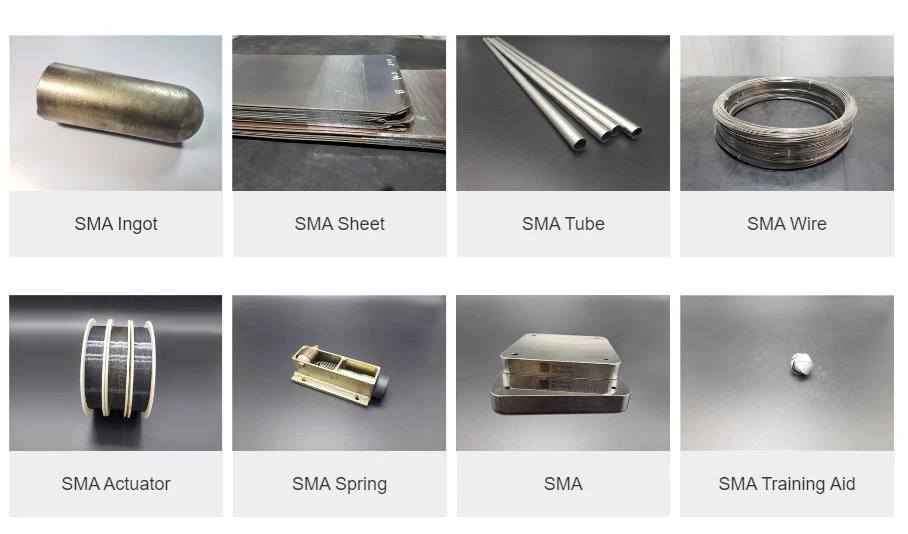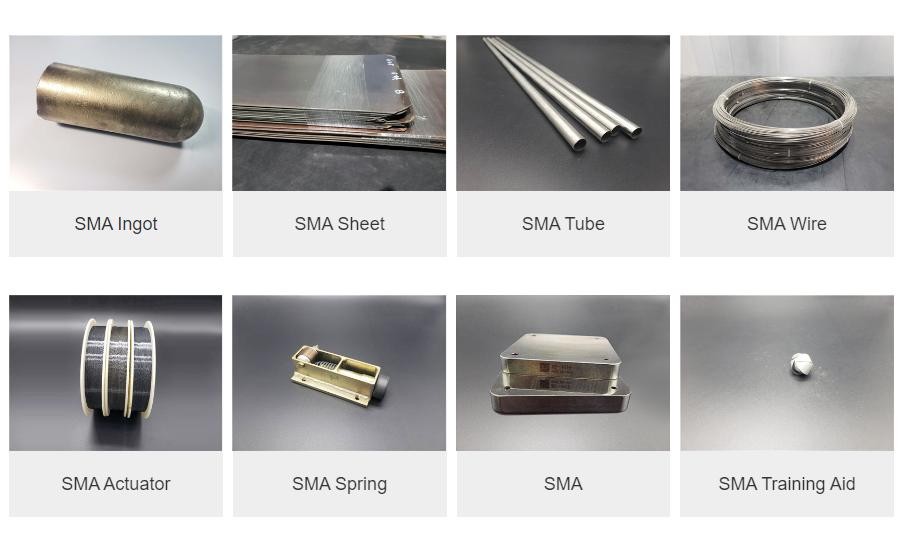Introduction

Nitinol, a memory-shape alloy, is a fascinating material with unique properties and versatile applications. Understanding the composition of this innovative alloy is crucial in unlocking its full potential. From the intricate process of machining nitinol to exploring its processing methods, there's much to discover about this remarkable material.
Understanding Nitinol Composition
Nitinol is a remarkable alloy composed of approximately equal parts nickel and titanium. Known for its unique combination of superelasticity and shape memory, nitinol has a wide range of applications.
This versatile material offers several key advantages:
- Superelasticity: Nitinol can undergo large deformations and return to its original shape without permanent damage.
- Shape Memory: Nitinol can be deformed at one temperature and recover its original shape when heated above a specific temperature.
- Corrosion Resistance: Nitinol is highly resistant to corrosion, making it suitable for various environments.
- Biocompatibility: Many nitinol alloys are biocompatible, enabling their use in medical devices.
These properties make nitinol invaluable for industries such as aerospace, medicine, and consumer products.
The Process of Machining Nitinol
Due to its unique composition and properties, machining nitinol requires precision and expertise. The process involves carefully shaping and refining the material to achieve the desired form while maintaining its exceptional characteristics. Every step in machining nitinol, from cutting to grinding, is crucial in harnessing its full potential.
Exploring Nitinol Processing
The processing of nitinol involves intricate techniques aimed at enhancing its superelasticity and shape memory capabilities. Through careful manipulation and heat treatment, nitinol can be tailored to suit specific applications, such as creating superelastic tubes or crafting precision instruments like nitinol knives.
The Wonders of Nitinol

Nitinol is a wonder material with unique characteristics that set it apart from traditional metals. Its shape memory and superelasticity properties make it a game-changer in various industries, allowing for innovative designs and applications previously impossible with conventional materials.
Unveiling Nitinol's Unique Characteristics
Nitinol is a remarkable shape memory alloy with unique properties that make it invaluable across various industries.
Nitinol's exceptional characteristics include:
- Shape memory effect: It returns to its original shape after deformation.
- Superelasticity: It undergoes significant deformation without permanent damage.
- Durability: It withstands extreme temperatures and harsh environments.
- Biocompatibility: It is safe for use in medical implants.
These properties make nitinol ideal for medical devices, aerospace engineering, and robotics applications. Its use in medical implants, such as stents and orthodontic wires, has revolutionized healthcare, enabling minimally invasive procedures and improved patient outcomes.
Unlocking the Potential of Superelastic Tube
One of the most fascinating applications of nitinol is in creating superelastic tubes. These tubes can undergo extreme bending and twisting without permanent deformation, making them perfect for minimally invasive medical procedures such as stent deployment and endoscopic surgery. The superelasticity of nitinol tubes enables them to adapt to the body's natural movements without causing discomfort or injury.
Nitinol's superelastic tubes have revolutionized medical devices, allowing for more precise and less invasive procedures. Their ability to bend and twist without permanent deformation means that they can navigate through the body's intricate pathways with ease, reducing the risk of damage to surrounding tissues. Their adaptability to the body's natural movements also ensures a more comfortable experience for patients undergoing stent deployment or endoscopic surgery.
Exploring the Uses of Nitinol Alloy Wire
Due to its remarkable properties, nitinol alloy wire has found widespread use in various industries. From orthodontic wires that apply gentle pressure to straighten teeth to actuators that provide precise motion control in robotics, nitinol alloy wire has revolutionized numerous fields. Its ability to contract when heated and expand when cooled makes it ideal for applications requiring precise and reliable actuation.
Nitinol alloy wire has also been utilized in the medical field for minimally invasive surgical procedures. Its superelasticity and shape memory properties allow for the creation of medical devices such as stents, guiding catheters, and guidewires. These devices can be inserted into the body in a compact form and then expand to their original shape once inside, reducing trauma to the patient. The biocompatibility of nitinol further enhances its suitability for medical applications, making it a valuable material in the healthcare industry.
How Nitinol is Made

Nitinol, a memory-shaped alloy, is primarily composed of nickel and titanium. It is created by carefully blending these two metals in precise proportions to achieve the desired properties. This unique composition allows nitinol to exhibit superelasticity and shape memory, making it an exceptional material for various applications.
The Intricate Process of Creating Nitinol
The creation of nitinol begins with carefully melting and mixing nickel and titanium in a controlled environment to ensure the proper combination of these two metals. The resulting alloy is then carefully processed through various heat treatment cycles to achieve the desired phase transformation behavior, which gives nitinol its remarkable properties. This intricate process requires precision and expertise to produce high-quality nitinol materials for use in different industries.
Understanding the Science Behind Nitinol Manufacturing
The science behind nitinol manufacturing involves deeply understanding metallurgy, thermodynamics, and material processing techniques. Engineers and scientists meticulously study the phase diagrams and material behavior to optimize the manufacturing process and enhance the performance of nitinol alloys. This scientific approach ensures that each batch of nitinol produced meets stringent quality standards and exhibits consistent mechanical properties.
Crafting Nitinol with Precision
Crafting nitinol with precision involves advanced machining techniques to shape the alloy into various forms, such as wires, tubes, or sheets. The intricate nature of working with nitinol requires specialized equipment and expertise to ensure that each component meets exact specifications. From cutting and grinding to polishing and finishing, every step in crafting nitinol requires meticulous attention to detail to deliver exceptional products that harness the full potential of this remarkable material.
Crafting nitinol with precision also involves a deep understanding of the material's unique properties and behavior. This knowledge is essential for determining the most effective machining techniques and processes to achieve the desired shapes and dimensions. Additionally, the expertise of skilled craftsmen plays a crucial role in ensuring that nitinol components are crafted with precision and accuracy, meeting the strict quality standards required for various applications.
Crafting Nitinol Knives

Nitinol knives are a marvel of modern engineering, combining steel's durability with nitinol's flexibility. Making nitinol knives involves precision machining and careful shaping to ensure the perfect balance of strength and resilience. Craftsmen use specialized techniques to mold and shape nitinol into razor-sharp blades that can withstand the toughest cutting tasks.
The Art of Making Nitinol Knives
Crafting nitinol knives is a delicate process that requires a deep understanding of the unique properties of this memory-shaped alloy. Each step in the production process is crucial in creating a high-quality knife, from selecting the right composition of nitinol to shaping and heat-treating the metal. Skilled artisans carefully mold and sculpt nitinol into sleek, sharp, functional, and visually stunning blades.
Perfecting the Technique of Nitinol Knife Making
Perfecting the making of nitinol knives involves honing one's skills in working with this extraordinary material. Machining nitinol requires precision tools and expert knowledge to ensure each knife is perfectly crafted. By mastering the art of manipulating nitinol's unique properties, craftsmen can create knives that are durable and possess an unparalleled ability to retain their shape even after intense use.
After mastering the art of working with nitinol, craftsmen must also focus on the design and ergonomics of their knives. A nitinol knife's shape, weight, and balance all contribute to its overall functionality and user experience. By paying attention to these details, craftsmen can ensure that their knives perform well and feel comfortable and natural in the hand.
Tips and Tricks for Creating Nitinol Knives
Crafting exceptional nitinol knives requires a deep understanding of this unique alloy. To excel in this craft, consider these essential tips:
- Master heat treatment: Precise temperature control is crucial for unlocking nitinol's full potential.
- Perfect shaping techniques: Shape the wire carefully to achieve the desired blade geometry.
- Prioritize finishing touches: A polished blade looks stunning and enhances performance.
By combining these elements with meticulous attention to detail, craftsmen can produce nitinol knives that are both beautiful and highly functional.
The Versatility of Nitinol

Nitinol is a remarkable material with diverse applications across various industries. From medical devices to aerospace engineering, its adaptability makes it an invaluable asset in modern technology.
Exploring the Diverse Applications of Nitinol
Nitinol's memory shape alloy allows it to return to its original form after deformation, making it ideal for medical stents, orthodontic wires, and even eyeglass frames. Its unique properties also make it suitable for actuators in robotics and sensors in automotive applications.
Nitinol's memory shape alloy has revolutionized minimally invasive surgery by providing a material that can be easily manipulated into a small diameter for insertion into the body and then return to its original shape once in place. This unique property has made Nitinol an essential material for medical stents used to open narrowed or blocked arteries. Its flexibility and resilience make it an ideal choice for orthodontic wires, allowing for more comfortable and efficient tooth movement during orthodontic treatment.
Innovative Uses for Nitinol in Various Industries
Nitinol is used in components such as actuators and valves in the aerospace industry due to its ability to withstand extreme temperatures and harsh environments. In the consumer goods sector, it is utilized in products like mobile phone antennas and thermal protection systems.
In the medical industry, nitinol is revolutionizing minimally invasive surgery with its shape memory properties, allowing for the creation of innovative surgical tools and implants. Nitinol's ability to create a memory-shaped alloy nitinol alloy wire offers endless possibilities for creating innovative and functional components. From superelastic tubes to intricate nitinol knives, this material's versatilityManufacturers can push the boundaries of what's possible in various industries by harnessing the potential of nitinol functional componentsUsingembracing the benefits of nitinol innovation is crucial to return to its original shape after being deformed makes it ideal for applications such as stents, guiding catheters, and orthodontic wires, providing patients with more effective and comfortable treatment options. Additionally, nitinol's biocompatibility and corrosion resistance make it a valuable material for medical devices that come into contact with bodily fluids.
Advancements in Nitinol Technology
As technology continues to advance, so does the potential for nitinol. Researchers are exploring new ways to enhance its superelasticity and shape memory properties, opening doors for even more innovative applications in fields such as energy storage and smart materials. One exciting area of development is the use of nitinol in biomedical devices, where its unique properties make it ideal for applications such as stents and orthodontic wires. Additionally, advancements in manufacturing techniques are making it easier and more cost-effective to produce nitinol components, further expanding its potential uses across various industries.
Invest in Quality Nitinol Materials

When it comes to working with nitinol, investing in high-quality materials is crucial for achieving optimal results. Whether you're crafting medical devices or precision instruments, the composition of nitinol plays a significant role in the functionality and durability of the end product. Understanding the intricacies of nitinol composition and sourcing top-notch materials is essential for success in any nitinol-related endeavor. Furthermore, collaborating with experienced suppliers and manufacturers can provide valuable insights into the latest advancements and best practices in working with nitinol, ensuring that your final product meets industry standards and exceeds customer expectations.
Harnessing the Potential of Nitinol Functional Components
The memory shape alloy nitinol alloy wire offers endless possibilities for creating innovative and functional components. From superelastic tubes to intricate nitinol knives, the versatility of this material allows for the development of cutting-edge products with unique capabilities. By harnessing the potential of nitinol functional components, manufacturers can push the boundaries of what's possible in various industries.
The use of nitinol functional components also opens up opportunities for advancements in medical devices and equipment. With its unique properties, nitinol can be utilized to create minimally invasive surgical tools, such as stents and guidewires, that offer improved patient outcomes and recovery times. Additionally, the biocompatibility of nitinol makes it an ideal material for implantable medical devices, further expanding the potential applications of this innovative alloy in the healthcare industry.
Embracing the Benefits of Nitinol Innovation
As advancements in machining nitinol and nitinol processing continue to evolve, it's crucial to embrace the benefits of nitinol innovation. From automotive engineering to aerospace applications, the diverse uses of nitinol are expanding rapidly, opening doors to new opportunities and groundbreaking technologies. By staying at the forefront of these innovations, businesses can position themselves as leaders in their respective fields.

